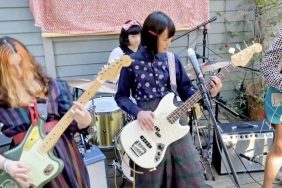When I bought issue #1 of Punk Rock Jesus, I was doing so just to hate it. As an old and bitter ex-hardcore kid, anything with the title “punk” in it immediately makes me wary. I figured Punk Rock Jesus would be another vapid look into a long dead and decayed genre by those who can only see it as a way to shill bad bands and T-shirts. In short, I was waiting for Corporate America to tell me what punk was all about.
Instead, what I found was a clever, emotional and stunning story from writer/artist Sean Murphy. Punk Rock Jesus captures the true punk spirit in every way. How it’s drawn, how the story is laid out, the characters, the pacing, the high middle finger to organized religion and corporate greed – it screams revolution the same way a Greg Ginn solo or HR battle cry would. Nothing has come close to the originality of Punk Rock Jesus in 2012 so I was thrilled to get to a chance to chat with Sean Murphy about comics, punk rock, religion and anything else we could think of.
***
CRAVE ONLINE: Your art is very visceral and has a lot of unique style and movement to it. Where did you learn how to draw? What artists inspire you?
SEAN MURPHY: I’ve been drawing for as long as I can remember. I took classes at a young age, then entered a master/apprentice relationship with a man in Salem, NH, named Leslie Swank – he was a WWII vet who loved cartooning and insisted I learn the basics about inking with the brush and quill. Eight years later, I was attending college, first at the Massachusetts College of Art and Design, then at SCAD.
My favorite three influences are Sergio Toppi, Jorge Zaffino, and Bill Watterson.
CRAVE ONLINE: What was the first punk album you bought? How did it change your life?
SEAN MURPHY: I listened to a lot of bad music when I was young – the only redeeming CD in my collection was a Bad Religion record I owned when I was 15. I admit, it didn’t change my life at first – no more than any of the 80s rock, metal, or grunge that I owned. In all honesty, it wasn’t until I started doing Punk Rock Jesus that I got more into punk. Mostly it was research – I didn’t want to do a book with that title and not be able to talk punk rock with people who read the book. But I eventually learned to love it.
My biggest punk influence is easily Henry Rollins – some of the Black Flag stuff, sure, but mostly the spoken word records he did. That stuff was my bread and butter for many years. As an homage, I tried drawing Chris in PRJ as a young Rollins. He even holds his microphone the way Rollins did (with the chord wrapped around his hand).
CRAVE ONLINE: You’ve said that Punk Rock Jesus was a project years in the making. What inspired the story? Was there a specific stressor that inspired you to write it?
SEAN MURPHY: Yeah, PRJ was years in the making. It started out as a story about Thomas, an IRA operative. But I could never make the plot work, so I set it aside. As the years passed, I left Christianity and became an atheist – instead of reading the Bible, I began reading about science. At some point, I was reading about the advancements in cloning, asked myself, “whom would the first clone be?,” decided that in the US, it would be Jesus, and soon had the basic plot for PRJ. I don’t think I ever set out to write, I just felt like I should try it. All the stuff I read at the time was published by Drawn and Quarterly, and most of those guys all write their own stuff.
At first, PRJ became away to funnel my atheist rage. But eventually I learned to pull back a little – I realized that if I was too preachy, I’d lose a lot of readers, and then NO message would get through. So to balance it out with religious characters, I folded in the Thomas McKael story, and began working on the pitch. Karen Berger [recently departed Executive Editor of Vertigo] helped me on the rest.
CRAVE ONLINE: What was the most difficult thing about writing PRJ?
SEAN MURPHY: The drawing. I don’t think writing is easy by any means, but for me, the long hours of drawing are a lot more taxing – emotionally and physically.
CRAVE ONLINE: You were raised Catholic but are now and atheist. What made you turn? What is your honest take on organized religion?
SEAN MURPHY: Part of it was the influence of my friend Zach Howard. I lived with him in Denver for a while, and he asked me a lot of questions that religion couldn’t answer. No one ever suggested to me that “god” might just be a man-made phenomenon, so I gave it a lot of thought. Many atheists I began reading about (Carl Sagan, Einstein, etc) seemed happy, well adjusted, and had better answers to questions that religion tried to answer.
For me, my faith fell apart in a month. I think the world makes a lot more sense as an atheist, and I’m a lot happier than I used to be.
CRAVE ONLINE: How difficult was it to both pencil and write PRJ? Was it hard to edit yourself in both aspects?
SEAN MURPHY: The Herculean task of doing both chores is really daunting, not only in the size of the work load, but also in the fact that there’s no one else on your team to depend on. If the book isn’t working, then there’s only me to blame. I think the psychology of working alone has been the biggest task of PRJ. Karen Berger did a lot to steer me in the right directions, and she contributed a lot of great ideas. But at the end of the day, I knew it was up to me.
CRAVE ONLINE: What do each of the characters in PRJ represent to you?
SEAN MURPHY: In a way, PRJ is an autobiography. Thomas represents how I used to be as a Catholic. Chris is me when I was a young and angry atheist. Dr. Epstein is the representation of the science that I’ve become such a fan of. Gwen is how innocent and naive I used to be. The NAC represents all the religious fanaticism that I luckily avoided. And Slate is the economical/business part of my brain, but to the point that he’s lost his soul. Almost everything in the book, from the motorcycle to furniture in J2, has some personal meaning for me.
CRAVE ONLINE: Which one of the PRJ characters is most like you? Why?
SEAN MURPHY: I relate a lot to Chris. While I agree with most everything he says, his tactics are wrong. He’s the version of me that never saw the value of diplomacy and patience. On my worst days, or when I’m drunk, I’m sure I can spout off a bit like Chris does from time to time. But I try not to.
CRAVE ONLINE: Would you like to see PRJ come out as an animated movie? Do you think the world is ready for it?
SEAN MURPHY: I’d love to see something else made out of it. Maybe an HBO mini series or something. Breaking Bad is a big influence on my writing – maybe AMC will take a chance on it one day. I think the world is becoming more ready for stories like PRJ, and it would be a kick seeing it interpreted by another medium. Animation included.
CRAVE ONLINE: How terrifying is Fox News to you?
SEAN MURPHY: 24 hour media in general is scary. We’re living in a time when elections never end – even now that the Presidential election is over, they’re focusing on the reaction of each party and their plans for the future. And they’re only doing it because they need CONTENT. As a society, part of making decisions is stepping back and taking a break. But the media isn’t letting us do that. I agree that FOX is more criminal that MSNBC and CNN, but lately I’ve been disappointed in all of them. Even Anderson Cooper is letting me down.
CRAVE ONLINE: Were you ever in a band? Do you play an instrument?
SEAN MURPHY: No, but I played the guitar and piano when I was a kid. But I quit them both because I wanted to pursue art. My parents were upset, but they supported my decision.
CRAVE ONLINE: What’s next for you?
SEAN MURPHY: Next I’m working on The Wake with Scott Snyder, a 12 issue maxi series coming out in 2013.









